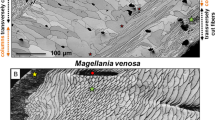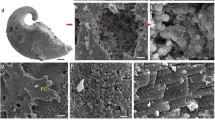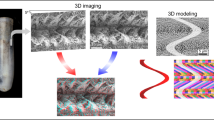Abstract
Snails of the superfamily Cavolinioidea, known as pteropods, are very abundant in the surface waters of all the oceans. Their transparent and lightweight shells are composed of densely packed, well-aligned, continuously crystalline curved aragonite fibers. Previous studies of the shell microstructure using mainly scanning electron microscopy, transmission electron microscopy, and x-ray diffraction suggested that the aragonite fibers adopt a helical motif. We mainly used focused ion beam-scanning electron microscopy to obtain three-dimensional information on the shell structure of Creseis acicula. We show that the basic structural motif in the central part of the shell (teleoconch) comprises aragonite fibers that are not helical, but are organized in nested S-shaped arcs arranged in planar arrays. This plane is oblique to the outer shell surface by approximately 20°. The planes stack in the third dimension with local displacements, to form a unique biological material.
Impact statement
Of the seven basic materials used by mollusks to build their shells, the structure of one of these materials remains enigmatic, even though the snails that form this structure are by far the most abundant mollusks on earth. These so-called pteropods live in the surface waters of all the oceans and produce a significant amount of all the calcium carbonate formed in the open oceans. Since the first study of the pteropod shell structure in 1972, the basic structural motif of the arrays of highly elongated aragonite crystal fibers was inferred to be helical, although no one actually documented an entire helix. Here we resolved the 3D structure of the shell of one pteropod species using an instrument (FIB-SEM) that produces a high resolution 3D structure. We show that the basic repeating unit is a planar layer of nested S-shaped aragonite crystal fibers. Furthermore this planar layer is oblique to the shell outer surface. Besides resolving a fundamental basic question concerning mollusk shell structures, this unique organization of crystals raises fascinating questions about the mechanical properties of this most unusual curved space filling structure that will hopefully inspire materials scientists to produce superior synthetic materials.










Similar content being viewed by others
Data availability
The data sets generated during and/or analyzed during the current study are available from the corresponding author on reasonable request.
Change history
15 March 2022
A Correction to this paper has been published: https://doi.org/10.1557/s43577-022-00269-7
References
O. Boggild, The Shell Structure of the Mollusks (A.F. Host, Kjobenhavn, Denmark, 1930)
J.G. Carter, G.R. Clark, in Mollusks. Notes for a Short Course, T.W. Broadhead, Ed. (University of Tennessee, Department of Geological Science Studies, 1985), pp. 50
F. Marin, N. Le Roy, B. Marie, Front. Biosci. 4, 1099 (2012)
J.G. Carter, Skeletal Biomineralization: Patterns, Processes and Evolutionary Trends (Van Nostrand Reinhold, New York, 1990)
G. Glaçon, J. Rampal, D. Gaspard, D. Guillaumin, T.S. Staerker, “Thecosomata (pteropods) and Their Remains in Late Quaternary Deposits on the Bougainville Guyot and the Central New Hebrides Island Arc,” in Proceedings of the Ocean Drilling Program Scientific Results (1994), p. 319
A.W.H. Bé, C. MacClintock, D.C. Currie, Biomineralization Res. Rep. 4, 47 (1972)
R.L. Batten, M.P. Dumont, Bull. Am. Mus. Nat. Hist. 157, 263 (1976)
A.W.H. Bé, R.W. Gilmer, “Zoogeographic and Taxonomic Review of Euthecosomatous Pteropoda,” in Oceanic Micropaleontology, A.T.S. Ramsay, Ed. (Academic Press, London, UK, 1977), vol. 1, p. 733
S. van der Spoel, Euthecosomata, A Group with Remarkable Developmental Stages (Gastropoda. Pteropoda) (Zoological Museum, Amsterdam, The Netherlands, 1967)
W. Sato-Okoshi, K. Okoshi, H. Sasaki, F. Akiha, Polar Biol. 33, 1577 (2010)
C. Salinas, D. Kisailus, JOM 65, 473 (2013)
K. Bandel, in Skeletal Biomineralization: Patterns, Processes and Evolutionary Trends, J. G. Carter, Ed. (Van Nostrand Reinhold, New York, 1990), p. 117
M. Suzuki, T. Sasaki, Y. Oaki, H. Imai, Cryst. Growth Des. 17, 191 (2016)
L. Li, J.C. Weaver, C. Ortiz, Nat. Commun. 6, 6216 (2015)
O. Sibony-Nevo, I. Pinkas, V. Farstey, H. Baron, L. Addadi, S. Weiner, Cryst. Growth Des. 19, 2564 (2019)
T. Zhang, Y. Ma, K. Chen, M. Kunz, N. Tamura, M. Qiang, J. Xu, L. Qi, Angew. Chem. 123, 10545 (2011)
A.G. Checa, E. Macías-Sánchez, J. Ramírez-Rico, Sci. Rep. 6, 25989 (2016)
M.G. Willinger, A.G. Checa, J.T. Bonarski, M. Faryna, K. Berent, Adv. Funct. Mater. 26, 553 (2015)
A.W. Janssen, Basteria 82, 110 (2018)
I. Belevich, M. Joensuu, D. Kumar, H. Vihinen, E. Jokitalo, PLoS Biol. 14, e1002340 (2016)
J. Schindelin, I. Arganda-Carreras, E. Frise, V. Kaynig, M. Longair, T. Pietzsch, S. Preibisch, C. Rueden, S. Saalfeld, B. Schmid, Nat. Methods 9, 676 (2012)
K. Bandel, Biomineralization Res. Rep. 9, 73 (1977)
H. Baron, Characterization of Shell Microstructures and the Shell-Tissue Interface of Shelled Pteropods from Cavoliniidae Family (Weizmann Institute of Science, Rehovot, Israel, 2014)
A. Watelet, T. Lefèvre, Ann. R. Soc. Malacol. Belg. 15, 100 (1885)
A.W. Janssen, K.T.C.A. Peijnenburg, in The Mediterranean Sea: Its History and Present Challenges, S. Goffredo, Z. Dubinsky, Eds. (Springer, Dordrecht, The Netherlands, 2014), p. 341
Acknowledgments
We thank L. Shimon for her help with x-ray diffraction. Super resolution microscopy was performed at the Irving and Cherna Moskowitz Center for Nano and Bio-Nano Imaging at the Weizmann Institute of Science.
Author information
Authors and Affiliations
Corresponding author
Ethics declarations
Ethical approval
None of the material has been published or is under consideration elsewhere, and that all co-authors are aware of and have approved the submission.
Additional information
This article was updated to correct the supplementary materials due to errors introduced during production.
Supplementary information
Below is the link to the electronic supplementary material.
ESM 1: Video 1 shows the 421 images from Stack B obtained sequentially from the outer surfaceto the inner surface (MPG 40501 kb)
ESM 2: Video 2 shows all the images in Stack B aligned parallel to the longitudinal section (MPG 25435 kb)
ESM 3: Video 3 shows all the images from Stack B parallel to the oblique plane (MPG 88641 kb)
ESM 4: Video S1. 3D volume of Stack A after cropping to an X, Y and Z volume of 13x9x11 microns respectively. The video shows the original images along the milling direction followed by a volume rendering mode to better highlight the crystal fiber trends (MPG 79970 kb)
ESM 5: Video S2. 3D structure of the entire high resolution Stack B. The video shows the original images obtained by FIB-SEM followed by volume rendering representation from different directions. The volume rendering mode highlights better the overall organization of the crystal fibers (MPG 48321 kb)
Rights and permissions
About this article
Cite this article
Sibony-Nevo, O., Rechav, K., Farstey, V. et al. The shell microstructure of the pteropod Creseis acicula is composed of nested arrays of S-shaped aragonite fibers: A unique biological material. MRS Bulletin 47, 18–28 (2022). https://doi.org/10.1557/s43577-021-00184-3
Accepted:
Published:
Issue Date:
DOI: https://doi.org/10.1557/s43577-021-00184-3




